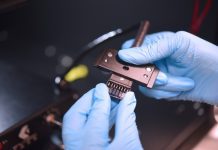
Researchers from the Queensland University of Technology (QUT) have discovered a new material that could advance the development of wearable electronics by improving flexible thermoelectric semiconductors.
The study, published in the journal Nature Communications, details how the QUT team enhanced the performance of a thermoelectric material—an alloy comprising silver, copper, tellurium, selenium, and sulphur—through a process known as “vacancy engineering.”
“Thermoelectric materials have drawn widespread attention over the past few decades in light of their unique ability to convert heat into electricity without generating pollution, noise, and requiring moving parts,” said lead author Nanhai Li.
By manipulating the empty atomic spaces, or vacancies, within the crystal structure of the alloy AgCu(Te, Se, S), the researchers improved both its thermal-to-electric conversion capability and its mechanical flexibility—key features for applications in wearable devices.
“As a continuous heat source, the human body produces a certain temperature difference with the surroundings, and when we exercise, that generates more heat and a larger temperature difference between the human body and the environment,” Li explained.
Working alongside Li were Dr Xiao-Lei Shi, Siqi Liu, Tian-Yi Cao, Min Zhang, Wan-Yu Lyu, Wei-Di Liu, Dongchen Qi and Professor Zhi-Gang Chen.
The research was conducted at the ARC Research Hub in Zero-emission Power Generation for Carbon Neutrality, within the QUT School of Chemistry and Physics and the QUT Centre for Materials Science.
Guided by advanced computational design, the team employed a simple and cost-effective melting method to synthesise the flexible thermoelectric material.
The resulting semiconductor not only exhibited strong thermoelectric performance but also demonstrated high ductility—making it adaptable for complex real-world uses.
To prove its applicability, the researchers created several micro-flexible prototypes, which could be comfortably worn on the arm, further underscoring the potential for the material in wearable electronics.
Professor Chen highlighted the growing demand for flexible thermoelectric solutions, noting that QUT’s innovation helps overcome key challenges associated with both organic and inorganic materials.
“Mainstream flexible thermoelectric devices rely on either organic materials, which tend to perform poorly, or inorganic ones, which are usually too brittle,” he said.
“This research identifies a rare inorganic compound that not only excels in energy conversion but also maintains the elasticity needed for wearable applications.”
The findings build on previous work by Professor Chen’s team, including a recent paper published in Science, which demonstrated the development of an ultra-thin, flexible film capable of powering wearables without batteries.
“The key to advancing flexible thermoelectric technology is to examine wide-ranging possibilities,” Chen said.
“Our work shows that by strategically engineering atomic vacancies, we can unlock new performance levels in materials previously thought to be limited.”
The full paper, Strategic vacancy engineering advances record-high ductile AgCu(Te, Se, S) thermoelectrics, is available online at Nature Communications.




















